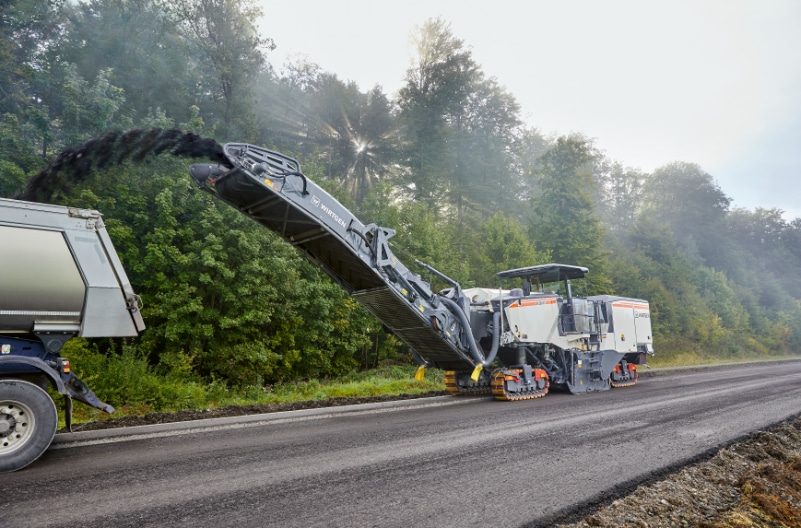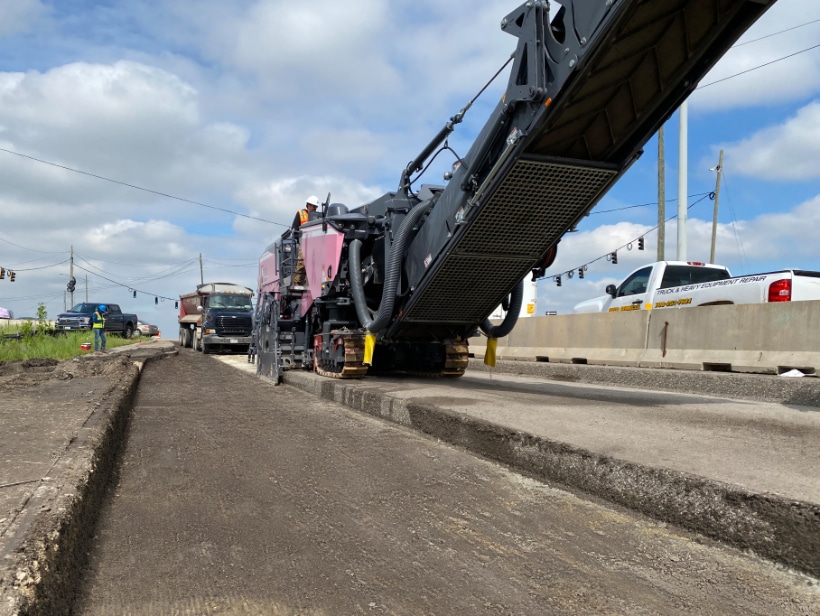How to Maintain Your Milling Machine
BY AsphaltPro Staff

When Tom Chastain presented the best practices of milling at CONEXPO-CON/AGG 2023, every tip and trick was based on one assumption: “Everything I’m saying is based on a well maintained machine.”
In Chastain’s 29 years in the milling industry, presently as milling product manager at Wirtgen America, Antioch, Tennessee, he’s learned the importance of properly maintaining one’s milling machine in order to achieve quality results.
“As soon as these machines hit the ground, they’re beating themselves to death. That’s their life,” Chastain said. “So we have to make sure we maintain them.” Here are a few of Chastain’s top tips for mill maintenance.
Start Your Walk-Around
A key step in any maintenance routine is to properly take care of the cutter drum, Chastain said. “The cutter drum is the lifeblood of a milling machine,” he said. “I could strap two jet engines to a milling machine, but if the cutter drum is not in proper working order, we’re not going to get production and we’re not going to get quality.”
Also check the kicker paddles on your drums. “They are there to help get the material out of the housing,” Chastain said. “If you don’t have those or they’re worn out, that material is just going to sit there in the housing and we’re going to be putting a lot more wear on the machine.”
If the material isn’t swiftly making its way out of the housing, chunks of material may get stuck on the conveyor belt. “Then they act just like pizza cutters and they start slicing up the belt,” he said. “If you don’t have a conveyor belt, you’re not milling.”
Chastain also suggests checking wear items on the housing, like the rear scraper, the front moldboard, the side plates, etc.

With a working width of 2.5 meters, the Wirtgen W 220 Fi mills off the 46 cm thick road surface in two passes on Interstate 55 in Bolingbrook, Illinois.
Spray to Play
It’s also important to check that the spray system is working correctly. “Water is our friend,” Chastain said. “It’s not only a cutting tool coolant, but it’s also a lubricant—and we want to keep those teeth rotating.”
Water also plays an important role in silica dust suppression and helps prevent buildup on the machine’s components. “It eats me up when I’m on a job site and someone says ‘I’m going to need you to mill dry because we’re going to be paving right behind you’,” Chastain said. “I’m like, ‘No you’re not, because we’ve got to broom it, and damp material is easier to broom up because it’s clumped together.’”
Chastain chooses to run soap in his water tank, but avoids Dawn and other surfactants. “Think about those Dawn commercials where they’re washing oil off of birds,” he said. He was on a job in western Canada where the milling crew went heavy on the Dawn. “They broomed it and tacked it, but there was still residual Dawn on the road that broke down the tack coat.”
Instead, he uses a capful of cheap liquid laundry soap a couple times a day. “If you’re going to put soap in the water tank, put water in first, then soap,” Chastain said. “If you put soap in first, the machine’s going to foam up like a rabid dog.”
Chastain points out that many new machines have multiple sections across the water bars. “With older machines, if we make a full pass then back up to make a half pass, we’re putting down a lot of water and end up with residual water that we’ve got to let dry out before we tack,” he said. “[With new machines] we can cut off sections of water to make sure we’re not doing that.”
Check & Change Teeth
A maintenance item worthy of its own section is checking the milling teeth and holders. “Every time a tooth makes contact with asphalt, it generates upwards of 1,800 degrees Fahrenheit,” Chastain said. “You take that heat and the abrasiveness of the material that we’re cutting, that’s where you actually start to get tooth wear.”
According to Chastain, the dead giveaway of a bad tooth is a white streak behind the mill. Although an operator may be tempted to wait until they see more than one streak, it’s important to change a bad tooth as soon as you see it or the wear might make its way to the holding.
“The way these drums are designed is that they hit at about a 36-degree angle, give or take 5 degrees of skewing,” Chastain said. “When we get to the holding and we put a new tooth in there, you might think you’re all good, but you’re not. We’ve changed the angle of attack of that holding. Now, you may not even be hitting the carbide. You’re going to be bouncing off the side of the body of that tooth. That tooth is going to wear out three to four times faster than the others.”
Behind the machine, this issue is going to look like a scuff mark like a crescent moon. “If you don’t replace that holding, you go from cutting asphalt to bludgeoning asphalt,” Chastain said. “That’s like trying to cut asphalt with a Baskin Robbins tasting spoon. It’s not going to work and the machine is going to let you know.”
Chastain was once on a job in Louisiana in an area with very abrasive rock. He suggested spot checking teeth every half-hour. When he left the job for 40 minutes, he could already see the white streak behind the mill from ½-mile away. In that time, the abrasive rock had damaged 30 holders on the drum. “The cost of operation goes through the roof with mistakes like that—and you can’t even say the word ‘quality’ at that stage,” he said.
As a crew mills, Chastain said the goal should be to see a uniform pattern behind the machine. “What we tend to see sometimes is new teeth in old holders or new holders with old teeth,” he said. “When you put a new tooth in with a bunch of used ones, it’s going to create a deeper groove. This can get our pattern all out of whack.”
Chastain gave the following suggestion: “Let’s say we cut a bunch of residential streets this week, but next week we’re going on the interstate. We might rerack that drum to start off fresh.” But, he said, do not throw away the removed teeth. “If they’ve still got 60 to 70% life on them, put them in a box and keep them with the machine. When you go out on that interstate project and you break a tooth, use one of those teeth because it’s going to match your pattern much better than a new tooth.”
Chastain also stresses the importance of always having spare teeth and holders. He was on a project in the middle of nowhere when the crew broke some teeth and forgot any spares. “The spare teeth were at the shop two and a half hours away,” he said. “Everything went downhill because we weren’t prepared for the job.”
Although some of these tips may seem basic, according to Chastain, “Advanced milling training is the basics.” Ultimately mill maintenance can boil down to one key question: “Ask yourself, ‘Have we maintained our machine to get quality?’”
